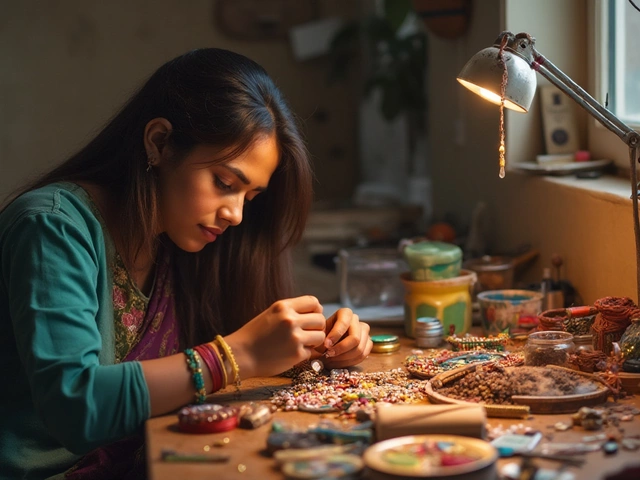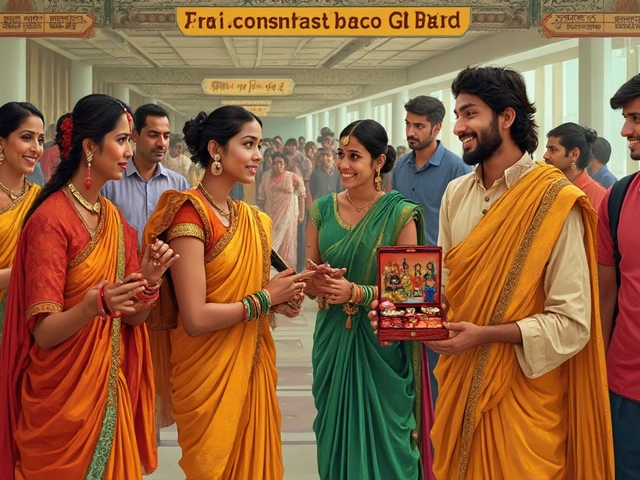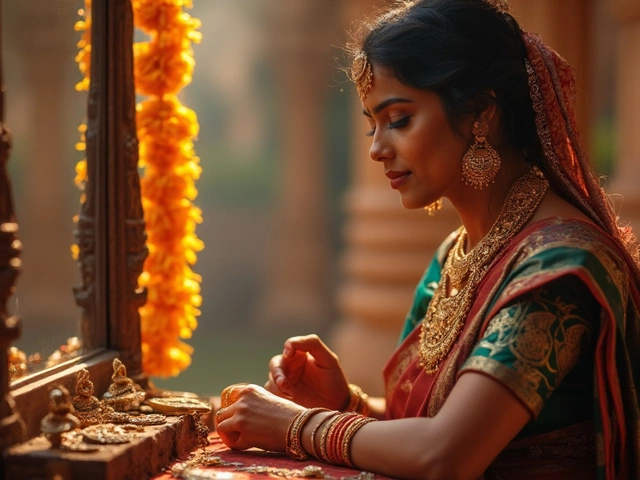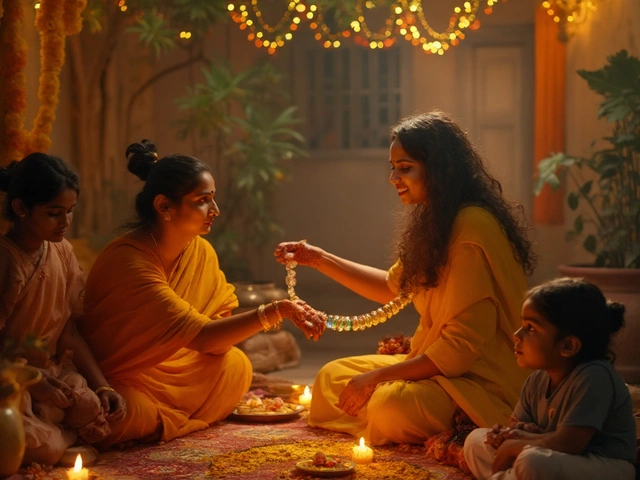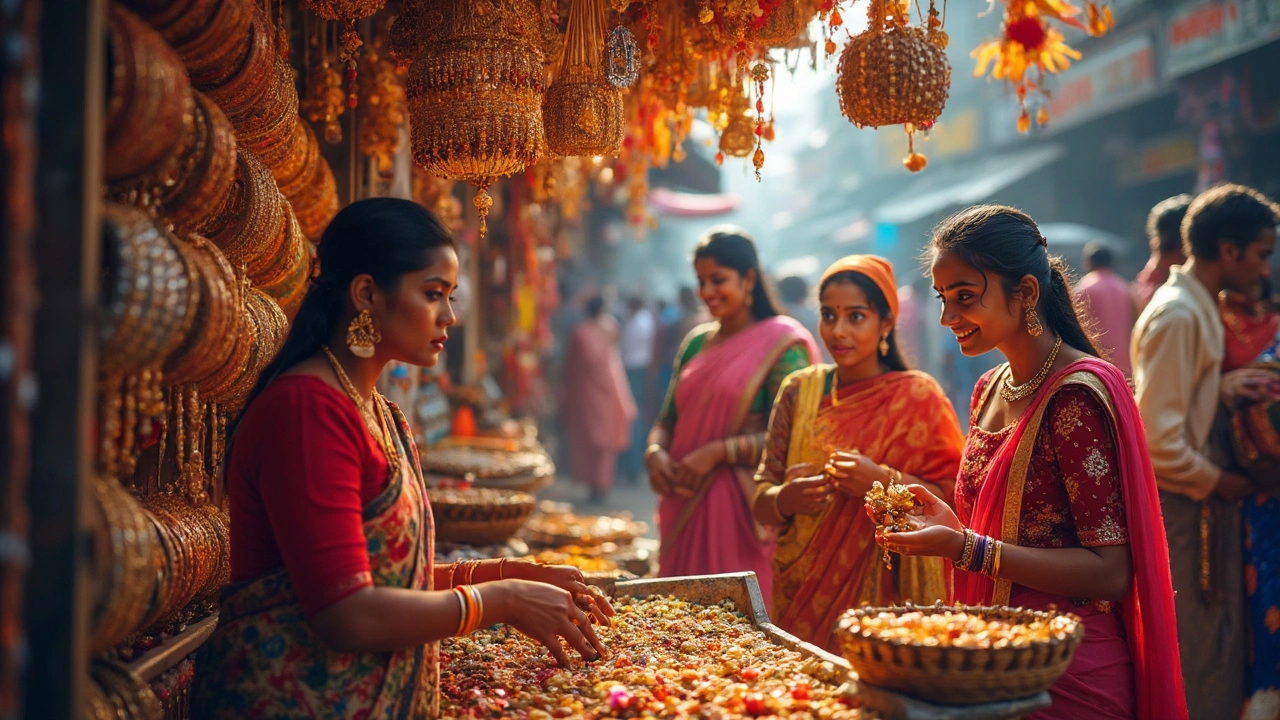
Ever wondered why bangles are such an integral part of Indian culture? Well, these vibrant wrist adornments aren't just about adding some bling to your look. They carry a whole lot of history and significance with them. From marriages to festivals, bangles have a place in almost every Indian tradition.
Different regions in India have their unique styles of bangles. For instance, the colorful glass bangles of Rajasthan and the intricate gold designs found in South India offer a glimpse into India's rich heritage. These styles not only bring out the cultural diversity of the country but also tell stories of the people and their traditions.
And there's more to bangles than meets the eye! Did you know that in many parts of India, bangles symbolize prosperity and good fortune? They are often part of marital rituals and can even indicate a woman's marital status. It's amazing how a single piece of jewelry can carry so much weight in terms of tradition and belief!
- Cultural Significance of Bangles
- Varieties and Styles Across Regions
- Symbolism and Rituals
- Tips for Choosing the Right Bangles
Cultural Significance of Bangles
Bangles in India aren't just pretty pieces to dangle from your wrists—they're a big deal on a cultural level. From a young age, many Indian girls are introduced to these vibrant accessories, and the connection only grows stronger with time. It's fascinating how something so simple can hold such deep cultural meaning, right?
Across various parts of India, bangles are tied deeply to a woman's identity and status. From weddings to religious ceremonies, these circular trinkets are always around, playing their subtle yet crucial roles. Married women, especially, often wear them as a symbol of prosperity, health, and good fortune. Interestingly, in some regions, you might even find them rattling a baby's wrist, as they're believed to ward off negative energy.
India, being a diverse nation, showcases a plethora of bangle traditions. Let's break it down regionally:
- In Punjab: Known for their 'Chooda', which is a set of red and white bangles worn by brides, signifying the start of their new life.
- In Maharashtrian Culture: Women wear green glass bangles, especially during weddings, symbolizing fertility and new beginnings.
- In Southern India: Gold bangles take precedence, often passed down as heirlooms representing the family's wealth and status.
Not only do they look beautiful, but bangles also play the role of a social connector. Women bond over styles, designs, and even the stories behind their most cherished ones. It’s like a vibrant, musical language that weaves through the fabric of Indian cultural life.
To give you a clearer picture of how integral these are, here's a quick breakdown:
| Occasion | Bangle Type |
|---|---|
| Diwali (Festival of Lights) | Colorful glass bangles |
| Weddings | Gold, Chooda, Green glass |
| Everyday wear | Simple metal or glass bangles |
Varieties and Styles Across Regions
India's diversity is vividly captured in the wide array of bangles you can find across its regions. Each state has its own signature style, making these traditional bangles not just pieces of jewelry but also symbols of a cultural identity.
Rajasthan: The Land of Vibrant Glass Bangles
Rajasthan is famed for its colorful glass bangles, which are usually worn in pairs. Women often stack them, creating a playful, jingling sound. These bangles are widely believed to bring good luck and are essential during wedding ceremonies.
South India: All About the Gold
Head down south, and you'll see that gold bangles rule the roost. Crafted with intricate designs, they are a status symbol and a crucial part of bridal jewelry. Families often pass down these gold bangles through generations, adding sentimental value to their allure.
Punjab: The Iconic 'Chooda'
In Punjab, the 'chooda', a set of red and white bangles traditionally worn by brides, holds a special place. These bangles are gifted by the bride's maternal uncle and represent happiness and prosperity in the marriage.
Bengal: The Elegant 'Shakha Pola'
Bengali brides wear 'shakha' and 'pola', bangles made from conch shell and red coral, respectively. These are not just worn for aesthetics; they're imbued with a deep-seated belief in protecting the bride and promoting a blissful married life.
These styles reflect the deeply rooted traditions and beliefs that bangles symbolize across India. The regional diversity in these ornaments tells stories of cultural heritage, making them much more than mere accessories.
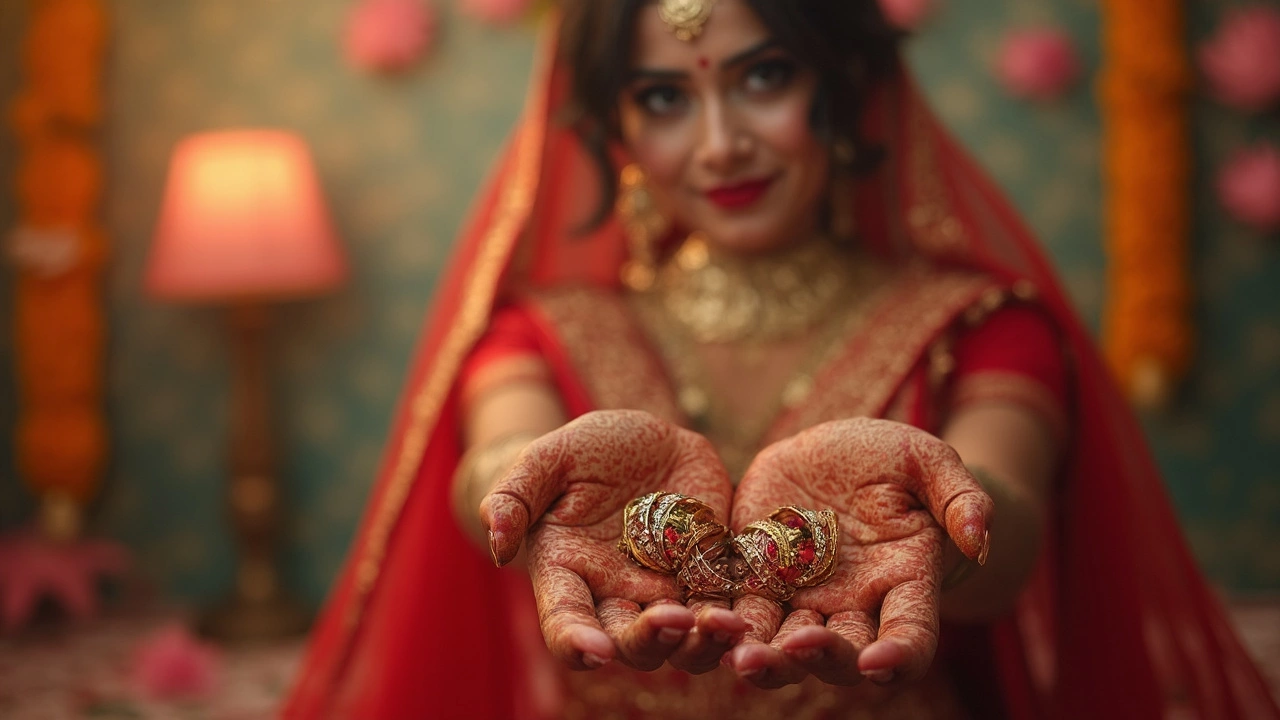
Symbolism and Rituals
Bangles in India are like a colorful thread that ties together history, culture, and spirituality. They're more than just decorative pieces; they play a fundamental role in many rituals and traditions across the country.
A Special Bond with Marriages
In Indian weddings, bangles are a significant part of a bride's attire. They're often made of gold, glass, or other precious materials. Brides traditionally wear red and green bangles which are believed to bring prosperity and fertility. The sound of clinking bangles is thought to create a positive aura around the bride, filling her new home with happiness and harmony. In fact, in many regions, a bride is not supposed to do household chores until she has worn her bangles for a certain number of days, symbolizing the beginning of a carefree and happy married life.
Different Bangles, Different Meanings
Across India, different communities imbue bangles with unique meanings. For instance, Punjabi brides wear ivory and red bangles called chooda, which symbolize prosperity and joy. Bengali brides wear shakha pola, made of conch-shell and red coral, as a sacred symbol.
These traditions are more than customs; they carry values and beliefs passed down through generations, interwoven with the diverse cultural tapestry of India.
Rituals Beyond Marriage
Bangles are not just confined to weddings. They are an integral part of other rituals throughout a woman’s life. During festivals, women wear bangles to add vibrancy to the celebrations, while during pregnancy, it is customary for expectant mothers to wear bangles in a ceremony called Godh Bharai or baby shower. The belief is that the sound of bangles protects the mother and the child, bringing joy and blessings.
The tradition of wearing bangles, thus, extends far beyond personal adornments. It’s about keeping the culture alive—one jingle at a time!
Tips for Choosing the Right Bangles
Picking the perfect bangles might seem like a tough task, but with a few simple tips, you can find those that not only look great but also hold personal significance. Here's how to make sure you get the right ones:
1. Know Your Size
It’s key to know your wrist size before buying. You don't want your bangles to be too tight or sliding off constantly. Measure your hand at the widest part with your thumb tucked in, and use that measurement to find the right size.
2. Material Matters
The material of your bangles can say a lot. Glass bangles are traditional, especially in parts of North India, while gold and silver bangles often indicate prosperity and are favored for weddings and festivals.
- Glass Bangles: These come in a variety of colors and are great for daily wear.
- Gold and Silver: Ideal for special occasions, they add a touch of elegance.
- Metal Bangles: Durable and perfect for both casual and festive looks.
3. Color and Design
Colors are not just about matching your outfit. In Indian tradition, red and green bangles are worn by married women, symbolizing prosperity and fertility. Vibrant colors can reflect festive spirit, so choose accordingly.
4. Consider the Occasion
Are you wearing them to a wedding or a casual day out? For weddings, heavier, elaborate designs are common, while lightweight designs work well for casual outings.
5. Budget Wisely
There’s no need to break the bank for a gorgeous set of bangles. Set a budget and explore options within that range. With countless choices, you can find beautiful bangles at almost any price point.
A simple way to keep track of the types you might want is to use a small table:
| Type | Best For |
|---|---|
| Glass | Daily wear |
| Gold | Weddings, Festivals |
| Silver | Festive occasions |
By keeping these points in mind, you can choose bangles that not only complement your look but also resonate with the rich traditions they represent.

